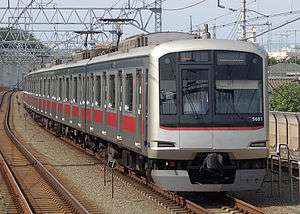Tōkyū Meguro Line
| Tokyu Meguro Line | |
|---|---|
| MG | |
 Tokyu 5080 series EMU on the Meguro Line | |
| Overview | |
| Native name | 東急目黒線 |
| Type | Commuter rail |
| Locale | Tokyo |
| Termini |
Meguro Hiyoshi |
| Stations | 13 |
| Operation | |
| Owner | Tokyu Corporation |
| Technical | |
| Line length | 11.9 km (7.4 mi) |
| Track gauge | 1,067 mm (3 ft 6 in) |
| Electrification | 1,500 V DC overhead catenary |
| Route diagram | ||||||||||||||||||||||||||||||||||||||||||||||||||||||||||||||||||||||||||||||||||||||||||||||||||||||||||||||||||||||||||||||||||||||||||||||||||||||||||||||||||||||||||||||||||||||||||||||||||||||||||||||||||||||||||||||||||||||||||||||||||||||||||||||||||||||||||||||||||||||||||||||||||||||||||||||||||||||||||||||||||||||||||||||||||||||||||||||||||||||||||||||||||||||||||||||||||||||||||||||||||||||||||||||||||||||||||||||||||||||||||||||||||||||
|---|---|---|---|---|---|---|---|---|---|---|---|---|---|---|---|---|---|---|---|---|---|---|---|---|---|---|---|---|---|---|---|---|---|---|---|---|---|---|---|---|---|---|---|---|---|---|---|---|---|---|---|---|---|---|---|---|---|---|---|---|---|---|---|---|---|---|---|---|---|---|---|---|---|---|---|---|---|---|---|---|---|---|---|---|---|---|---|---|---|---|---|---|---|---|---|---|---|---|---|---|---|---|---|---|---|---|---|---|---|---|---|---|---|---|---|---|---|---|---|---|---|---|---|---|---|---|---|---|---|---|---|---|---|---|---|---|---|---|---|---|---|---|---|---|---|---|---|---|---|---|---|---|---|---|---|---|---|---|---|---|---|---|---|---|---|---|---|---|---|---|---|---|---|---|---|---|---|---|---|---|---|---|---|---|---|---|---|---|---|---|---|---|---|---|---|---|---|---|---|---|---|---|---|---|---|---|---|---|---|---|---|---|---|---|---|---|---|---|---|---|---|---|---|---|---|---|---|---|---|---|---|---|---|---|---|---|---|---|---|---|---|---|---|---|---|---|---|---|---|---|---|---|---|---|---|---|---|---|---|---|---|---|---|---|---|---|---|---|---|---|---|---|---|---|---|---|---|---|---|---|---|---|---|---|---|---|---|---|---|---|---|---|---|---|---|---|---|---|---|---|---|---|---|---|---|---|---|---|---|---|---|---|---|---|---|---|---|---|---|---|---|---|---|---|---|---|---|---|---|---|---|---|---|---|---|---|---|---|---|---|---|---|---|---|---|---|---|---|---|---|---|---|---|---|---|---|---|---|---|---|---|---|---|---|---|---|---|---|---|---|---|---|---|---|---|---|---|---|---|---|---|---|---|---|---|---|---|---|---|---|---|---|---|---|---|---|---|---|---|---|---|---|---|---|---|---|---|---|---|---|---|---|---|---|---|---|---|---|---|---|---|---|---|---|---|---|---|---|---|---|---|---|---|---|---|---|---|---|---|---|---|---|---|---|---|---|---|---|---|---|---|---|---|---|
| ||||||||||||||||||||||||||||||||||||||||||||||||||||||||||||||||||||||||||||||||||||||||||||||||||||||||||||||||||||||||||||||||||||||||||||||||||||||||||||||||||||||||||||||||||||||||||||||||||||||||||||||||||||||||||||||||||||||||||||||||||||||||||||||||||||||||||||||||||||||||||||||||||||||||||||||||||||||||||||||||||||||||||||||||||||||||||||||||||||||||||||||||||||||||||||||||||||||||||||||||||||||||||||||||||||||||||||||||||||||||||||||||||||||
The Tokyu Meguro Line (東急目黒線 Tōkyū Meguro-sen) is a railway line operated by Japanese private railway company Tokyu Corporation. As a railway line, the name is for the section between Meguro and Den-en-chōfu in southwest Tokyo, but nearly all trains run to Hiyoshi on a quad-tracked section of the Tōyoko Line in Yokohama, Kanagawa.
The Meguro line interoperates with the Tokyo Metro Namboku Line and Toei Mita Line beyond Meguro. Until this connection was established in 2000, the line was a part of the Mekama Line, and ran between Meguro and Kamata. The rest of the Mekama Line was named the Tōkyū Tamagawa Line. On June 22, 2008, new tracks for the Meguro Line trains from Motosumiyoshi to Hiyoshi stations were added.
Express services between Musashi-Kosugi and Meguro started on September 25, 2006, and was extended to Hiyoshi on June 22, 2008. The Express saves 5 minutes over the route and overtakes local trains at Musashi-Koyama. Express trains operate during the daytime one in every 4 to 5 trains, with higher frequencies during peak periods.
Stations
| No. | Station | Japanese | Express | Transfers | Location | |
|---|---|---|---|---|---|---|
| ↑ Through-running to/from the NTokyo Metro Namboku Line towards Urawa-Misono via the Saitama Rapid Railway Line ↑ ↑ Through-running to/from the IToei Mita Line towards Nishi-Takashimadaira ↑ | ||||||
| MG01 | Meguro | 目黒 | ● | Shinagawa | Tokyo | |
| MG02 | Fudō-mae | 不動前 | | | |||
| MG03 | Musashi-Koyama | 武蔵小山 | ● | |||
| MG04 | Nishi-Koyama | 西小山 | | | |||
| MG05 | Senzoku | 洗足 | | | Meguro | ||
| MG06 | Ōokayama | 大岡山 | ● | OM Tokyu Oimachi Line | Ōta | |
| MG07 | Okusawa | 奥沢 | | | Setagaya | ||
| MG08 | Den-en-chōfu | 田園調布 | ● | TY Tokyu Toyoko Line | Ōta | |
| MG09 | Tamagawa | 多摩川 | ● |
| ||
| MG10 | Shin-Maruko | 新丸子 | | | TY Tokyu Toyoko Line | Nakahara-ku, Kawasaki | Kanagawa |
| MG11 | Musashi-Kosugi | 武蔵小杉 | ● |
| ||
| MG12 | Motosumiyoshi | 元住吉 | | | TY Tokyu Toyoko Line | ||
| MG13 | Hiyoshi | 日吉 | ● |
|
Kōhoku-ku, Yokohama | |
Rolling stock
Tokyu
- 3000 series 6-car EMUs
- 5080 series 6-car EMUs
Other operators
- Saitama Rapid Railway 2000 series 6-car EMUs (Saitama Rapid Railway Line)
- Toei 6300 series 6-car EMUs (Toei Mita Line)
- Tokyo Metro 9000 series 6-car EMUs (Tokyo Metro Namboku Line)
History
- 1923:
- March 11: The line opens as the Meguro Line between Meguro and Maruko (now Numabe) (on the current Tamagawa Line).
- October: Meguro-Fudōmae station is renamed to Fudōmae station.
- November 1: The line is extended from Maruko to Kamata, and the line is renamed to the Mekama line.
- 1924, June 1: Koyama becomes Musashi-Koyama.
- 1926, January 1: Chōfu and Tamagawa stations are renamed to Den-en-Chōfu and Maruko-Tamagawa stations respectively.
- 1928, August 1: Nishi-Koyama station opens.
- 1931, January 1: Maruko-Tamagawa station is renamed again to Tamagawa-en-mae station.
- 1977, December 16: Tamagawa-en-mae station is renamed yet again to Tamagawa-en station.
- 1994, November 27: Den-en-Chōfu station moves underground.
- 1997:
- June 27: Ōokayama station moves underground.
- July 27: Meguro station moves underground.
- 1999, October 10: Fudōmae station is elevated.
- 2000:
- August 6: Service is split into two services, Meguro - Musashi-Kosugi and Tamagawa - Kamata. Tamagawa-en station is renamed to Tamagawa station and one-man operation begins.
- September 26: Through service begins with the Tokyo Metro Namboku and Toei Mita Lines.
- 2001, March 28: Through service begins with the Saitama Rapid Railway line via the Namboku line.
- 2006:
- July 2: As part of a grade separation project between Fudōmae and Senzoku, Musashi-Koyama and Nishi-Koyama stations move underground.
- September 25: Express service commences.
- 2008, June 22: Service extended to Hiyoshi.
Former connecting lines
- Okusawa station - A 1 km 1067mm gauge line, electrified at 600 VDC, from Shin-Okusawa operated between 1928 and 1935, providing a connection to Yukigaya-Otsuka on the Tokyu Ikegami Line.
See also
References
This article incorporates material from the corresponding article in the Japanese Wikipedia